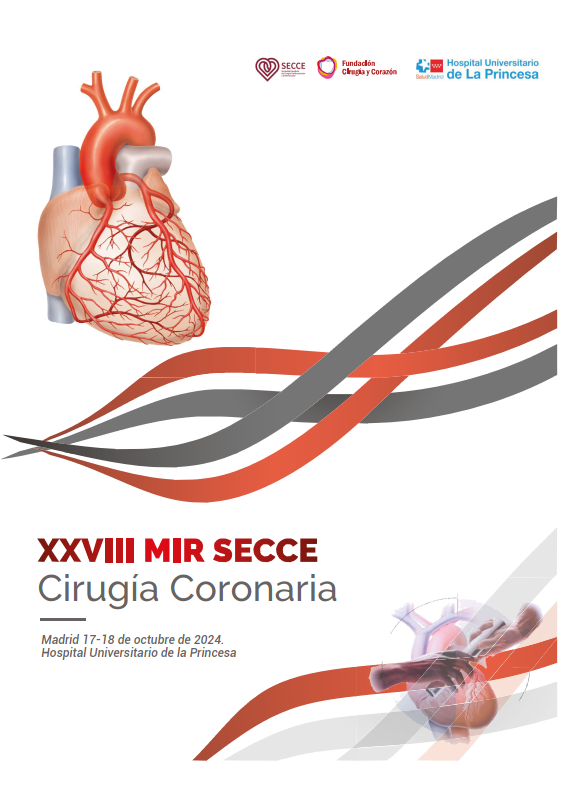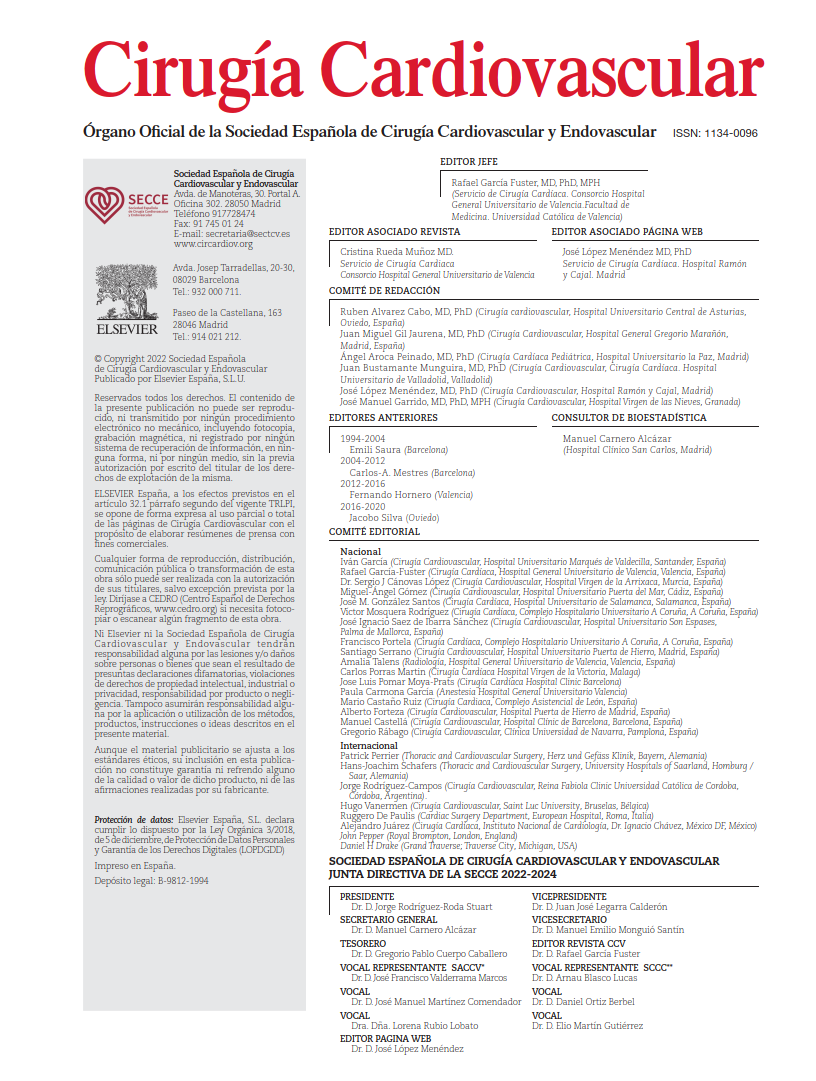Complicated type B aortic dissection is a high-risk vascular emergency requiring immediate therapeutic action. Clinical presentation may include visceral, renal or spinal cord ischemia, persistent pain, rapid expansion or impending rupture of the false lumen. In these scenarios, endovascular treatment (TEVAR) has replaced exclusive medical management, showing improved short-term survival when performed early and safely.
Although its use has become widespread, TEVAR in the acute phase demands precise anatomical planning and flawless surgical execution. Every step—from vascular access and guidewire advancement to endograft deployment—has critical implications for the final outcome. Moreover, multidisciplinary collaboration among cardiac surgeons, vascular surgeons, radiologists and imaging technicians is essential, as the approach to this condition may vary depending on each hospital’s structure.
The aim of this article is to break down, step by step, the essential technical aspects of performing safe TEVAR in the setting of complicated type B aortic dissection, highlighting key surgical decisions, practical details, and recommendations based on the most recent literature. To this end, specific suggestions will be provided for each step in the technical description of the procedure:
- Step-by-step technical description
The cornerstone of a safe and effective TEVAR is meticulous planning based on CT angiography with multiplanar reconstructions. This imaging must allow accurate assessment of the location of the proximal entry tear, the extent of the dissection, the degree of true lumen collapse, and the involvement of visceral branches. For the procedure to be feasible, several minimum anatomical criteria must be met: a proximal landing zone of at least 2.5 cm of healthy aorta (free of dissection or thrombus), an appropriate true lumen or non-dissected aortic diameter—since oversizing, typically 10–15%, should be calculated only over non-dissected tissue—and the absence of severe tortuosity or calcification of the femoral and iliac access routes. Rigorous evaluation of these parameters is essential to minimize complications, prevent endoleaks, and ensure stable endograft fixation.
Access site selection is also critical. Bilateral femoral access is the standard approach and should always be guided by duplex ultrasound or fluoroscopy. If there is uncertainty regarding vessel caliber or tortuosity, surgical femoral exposure or even direct iliac access should be considered, particularly in elderly patients or those with peripheral vascular disease.
- Guidewire navigation and positioning
The goal is always the same: to reach the true lumen in the ascending aorta and advance safely from there in a distal direction. The procedure begins with the advancement of a hydrophilic or 0.035″ guidewire through the true lumen up to the ascending aorta. A pigtail catheter is then used to exchange it for a stiff guidewire, such as a Lunderquist, which provides the necessary support for advancing and deploying the stent graft.
Navigation can be challenging in extensive dissections or those with significant true lumen collapse. In such cases, if IVUS is not available, transesophageal echocardiography (TEE) can be a critical tool to confirm that the wire is advancing within the true lumen, particularly in the proximal segment. TEE is a very useful and safe option in hybrid ORs that lack intravascular ultrasound capabilities.
The entire maneuver is performed under continuous angiographic guidance. A left anterior oblique (LAO) projection is typically used, as it provides optimal alignment of the aortic arch axis and clearer visualization of the spatial relationship between the descending aorta and supra-aortic branches. This projection facilitates precise identification of the left subclavian artery origin, which is key to determining the exact landing zone of the stent graft and avoiding inadvertent coverage of vital branches. Simultaneously, a second pigtail catheter is introduced via the contralateral femoral artery, allowing contrast injection and a full aortogram in this projection. This step is essential to confirm the anatomy, visualize critical landmarks such as the left subclavian origin, and accurately define the proximal implantation site in real time.
- Device selection and preparation
Device choice depends on institutional availability and the surgical team’s familiarity with the system. It is essential that the operator is experienced with at least one or two specific models, as each delivery system has its own technical nuances, and acute aortic syndromes do not allow for improvisation.
Commonly used devices include Gore TAG®, Zenith TX2®, and Relay Pro®, among others. The selected stent graft should be prepared on the table in advance, confirming the measurements, delivery system configuration, and position of radiopaque markers.
- Stent graft deployment
The device is deployed over the stiff guidewire, positioning the proximal end just distal to the origin of the left subclavian artery—or covering it if necessary to achieve adequate sealing. The left anterior oblique (LAO) projection is preferred, as it provides clear visualization of the brachiocephalic trunk bifurcation and facilitates precise positioning.
In certain cases, rapid ventricular pacing is used to induce transient tachycardia (typically 180–220 bpm), thereby momentarily reducing cardiac output and aortic pulsatility. By decreasing aortic motion during the critical deployment phase, this maneuver minimizes the risk of device misalignment or migration.
- Left subclavian artery considerations
When coverage of the left subclavian artery is necessary to ensure proximal sealing, prior revascularization with a carotid–subclavian bypass should be considered. This is especially recommended in cases of left vertebral dominance, a patent internal mammary artery graft, or neurological symptoms suggestive of vertebrobasilar ischemia. In the absence of these risk factors, revascularization may be postponed and performed as a second-stage procedure if the patient remains stable.
- Post-implantation assessment and access site closure
Following stent graft deployment, a final angiographic evaluation is performed by injecting contrast through a pigtail catheter introduced within the stent graft. This step confirms correct sealing of the proximal entry tear, absence of endoleaks, distal perfusion through the true lumen, and adequate flow to the visceral and renal arteries.
Immediate angiographic control should be complemented with close clinical follow-up and scheduled imaging, typically with CTA, particularly during the first months. This allows for early detection of complications such as persistent endoleaks, distal true lumen collapse, or disease progression.
Femoral access closure can be achieved using percutaneous techniques such as the ProGlide® or ProStyle® systems, which require a preclosure strategy—that is, deployment of the closure device at the beginning of the procedure. Alternatively, the MANTA® device allows for postprocedural closure without predeployment. If vascular access is inadequate or complications arise during sheath insertion, conventional surgical closure remains a safe and effective option.
COMMENTARY:
The TEVAR technique described aligns with the current recommendations of the 2024 STS/EACTS guidelines, which favor endovascular treatment for complicated type B dissections whenever suitable anatomy and an experienced team are available. The article by Lombardi et al. clearly outlines the essential technical steps, while leaving room to emphasize practical aspects that can be critical in real-world scenarios.
One such aspect is the identification of the true lumen. Although IVUS is described as the ideal modality for this purpose, it is not routinely available in many centers. In these cases, transesophageal echocardiography (TEE) can be particularly valuable in confirming that the guidewire has advanced through the true lumen, especially in its proximal portion, before proceeding with stent graft delivery. TEE is a safe and accessible option in hybrid operating rooms and cath labs with anesthetic support, providing reassurance without requiring advanced imaging platforms.
Another important consideration is the management of the left subclavian artery. Most authors recommend carotid-subclavian bypass when there is dominant left vertebral artery flow, a patent left internal mammary artery graft, or neurologic symptoms suggestive of vertebrobasilar ischemia. However, in urgent settings, many teams choose to proceed directly with stent graft deployment and defer revascularization unless clinical signs of malperfusion arise. This pragmatic approach should be adapted based on institutional resources and patient stability.
Additionally, the use of a stiff guidewire and rapid ventricular pacing to facilitate deployment is not always emphasized in published protocols, yet proves highly relevant in everyday practice. Rapid pacing reduces aortic pulsatility and movement, making accurate deployment easier—especially in curved segments of the arch where precise positioning is critical. In cases of poor alignment or high aortic mobility, this strategy can help avoid suboptimal sealing or graft migration.
A final step that is often underreported but essential is completion angiography using a pigtail catheter passed through the inside of the stent graft. This control confirms complete expansion of the prosthesis, the absence of endoleaks, and continued perfusion of the visceral branches. This simple yet crucial check should be standardized in every TEVAR procedure.
It is also necessary to acknowledge the realities of hospital practice. Although TEVAR has traditionally been part of the cardiac surgeon’s toolbox, in many institutions it is now led by vascular surgeons or interventional radiologists. However, any cardiac surgeon involved in these procedures should be proficient in deploying at least one or two stent graft models available at their center. Each delivery system has unique characteristics, and acute dissections leave no room for improvisation. TEVAR involves reproducible steps, but demands complete technical mastery.
At our university hospital in A Coruña (CHUAC), cardiac surgeons routinely manage complicated type B aortic dissections. When additional support is needed due to anatomical or technical complexity, interventional radiologists and vascular surgeons are involved, allowing the strategy to be tailored to each case. Moreover, collaboration with radiology technicians has become increasingly important, as their presence during on-call shifts ensures high image quality, procedural efficiency, and reduced error rates.
Endovascular treatment of complicated type B aortic dissection not only improves acute-phase survival but has become a core skill for cardiovascular surgeons, particularly in institutions where these patients present as emergencies. While the steps of TEVAR may appear standardized, they require meticulous planning, deep understanding of the chosen stent graft platform, and experience with advanced transcatheter techniques. Familiarity with one or two devices is essential to avoid deployment errors, as these systems—although similar—differ in key functional aspects.
Mastering TEVAR is not merely about deploying a graft; it is about understanding the clinical and anatomical rationale behind each step. This article, together with current guidelines, provides an opportunity for surgeons to review, consolidate, and systematize their approach. For younger surgeons, developing TEVAR proficiency is not just a technical requirement—it is a matter of surgical leadership in high-stakes settings and multidisciplinary teamwork in complex cases.
REFERENCES:
Lombardi JV, Hughes GC, Ouriel K, et al. Endovascular therapy for acute type B aortic dissection. Oper Tech Thorac Cardiovasc Surg. 2024;30:26–43. doi:10.1053/j.optechstcvs.2023.06.006.
Leshnower BG, Chen EP. TEVAR for acute complicated type B aortic dissection. Oper Tech Thorac Cardiovasc Surg. 2018;23(1):21–33. doi:10.1053/j.optechstcvs.2018.03.003.
Czerny M, Grabenwöger M, Berger T, Aboyans V, Della Corte A, Chen EP, et al. EACTS/STS guidelines for diagnosing and treating acute and chronic syndromes of the aortic organ. Eur J Cardiothorac Surg. 2024;65(2):ezad426. doi:10.1093/ejcts/ezad426.



